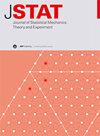大偏差产生的凝聚过程
IF 1.9
3区 物理与天体物理
Q2 MECHANICS
Journal of Statistical Mechanics: Theory and Experiment
Pub Date : 2024-04-03
DOI:10.1088/1742-5468/ad2dda
引用次数: 0
摘要
金曼(Kingman)提出了在固定环境下中性演化种群系谱的经典模型。金曼的凝聚过程产生了一棵二叉树,它普遍存在于后代数量方差有限的许多微观模型中。据了解,具有无限方差的幂律后代分布会导致一种非常不同的凝聚结构,即两个以上的品系合并。在这里,我们将研究子代分布方差有限但与种群数量相当的情况。这是通过研究后代大小对数具有拉伸指数尾部的模型来实现的。这种后代分布的动机不仅来自于生物学,即在异质环境中生长的玩具模型,还来自于数学和统计物理学,其中随机指数和的极限定理和相变因出现在德里达的随机能量模型(REM)的分区函数中而受到广泛关注。我们发现,极限凝聚是一种 β 凝聚--这是以前研究过的具有重尾后代分布的进化动力学模型中出现的模型。我们还讨论了与之前关于 REM 结果的联系。本文章由计算机程序翻译,如有差异,请以英文原文为准。
Coalescent processes emerging from large deviations
The classical model for the genealogies of a neutrally evolving population in a fixed environment is due to Kingman. Kingman’s coalescent process, which produces a binary tree, emerges universally from many microscopic models in which the variance in the number of offspring is finite. It is understood that power-law offsprings distributions with infinite variance can result in a very different type of coalescent structure with merging of more than two lineages. Here, we investigate the regime where the variance of the offspring distribution is finite but comparable to the population size. This is achieved by studying a model in which the log offspring sizes have stretched exponential tails. Such offspring distributions are motivated by biology, where they emerge from a toy model of growth in a heterogeneous environment, but also from mathematics and statistical physics, where limit theorems and phase transitions for sums over random exponentials have received considerable attention due to their appearance in the partition function of Derrida’s random energy model (REM). We find that the limit coalescent is a β -coalescent—a previously studied model emerging from evolutionary dynamics models with heavy-tailed offspring distributions. We also discuss the connection to previous results on the REM.
求助全文
通过发布文献求助,成功后即可免费获取论文全文。
去求助
来源期刊
CiteScore
4.50
自引率
12.50%
发文量
210
审稿时长
1.0 months
期刊介绍:
JSTAT is targeted to a broad community interested in different aspects of statistical physics, which are roughly defined by the fields represented in the conferences called ''Statistical Physics''. Submissions from experimentalists working on all the topics which have some ''connection to statistical physics are also strongly encouraged.
The journal covers different topics which correspond to the following keyword sections.
1. Quantum statistical physics, condensed matter, integrable systems
Scientific Directors: Eduardo Fradkin and Giuseppe Mussardo
2. Classical statistical mechanics, equilibrium and non-equilibrium
Scientific Directors: David Mukamel, Matteo Marsili and Giuseppe Mussardo
3. Disordered systems, classical and quantum
Scientific Directors: Eduardo Fradkin and Riccardo Zecchina
4. Interdisciplinary statistical mechanics
Scientific Directors: Matteo Marsili and Riccardo Zecchina
5. Biological modelling and information
Scientific Directors: Matteo Marsili, William Bialek and Riccardo Zecchina

 求助内容:
求助内容: 应助结果提醒方式:
应助结果提醒方式:


